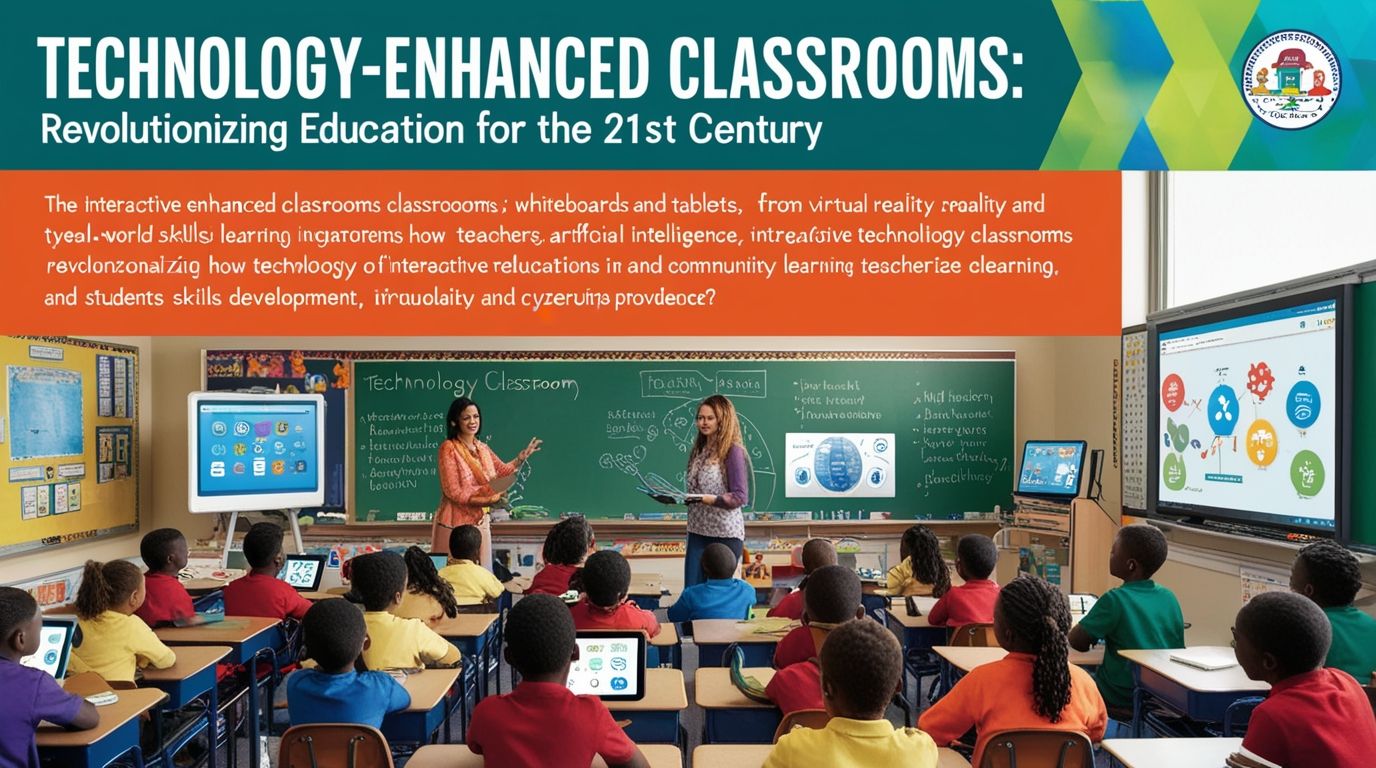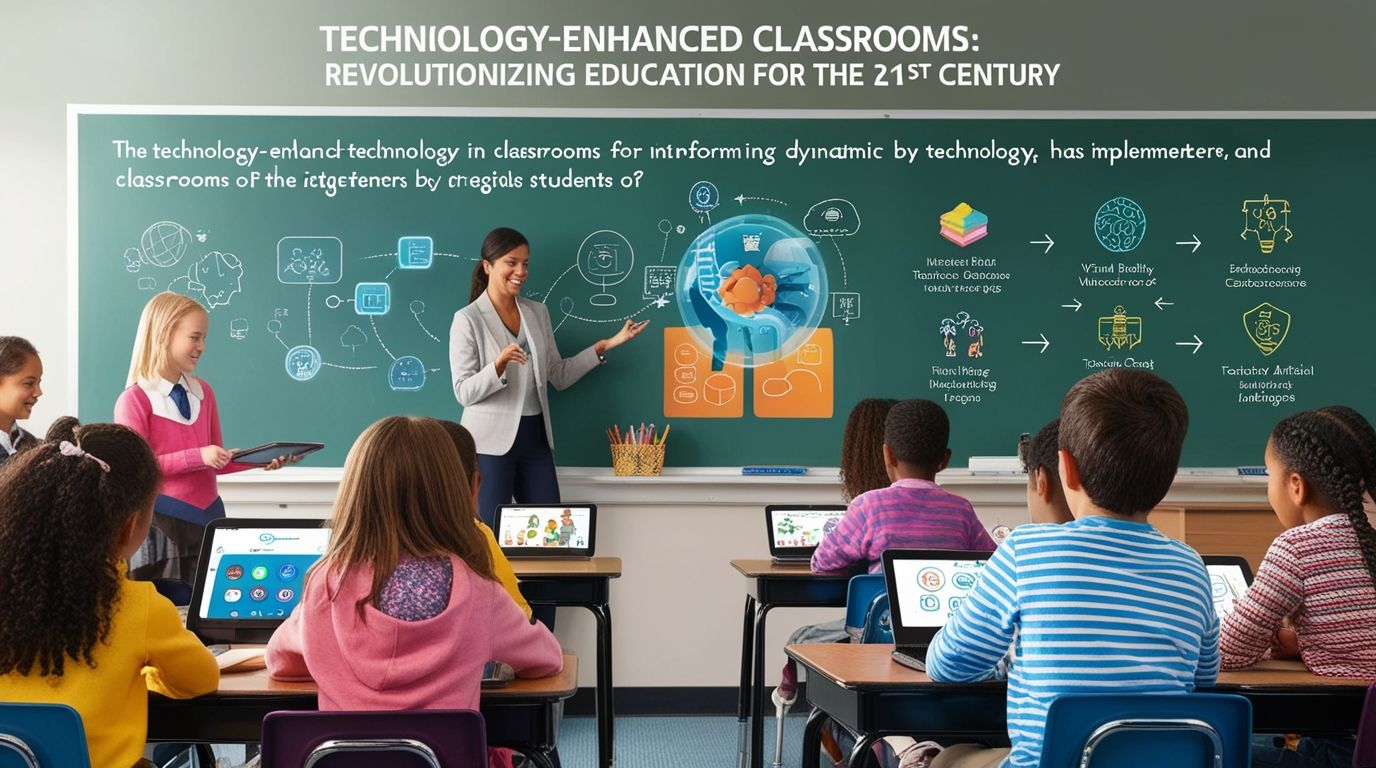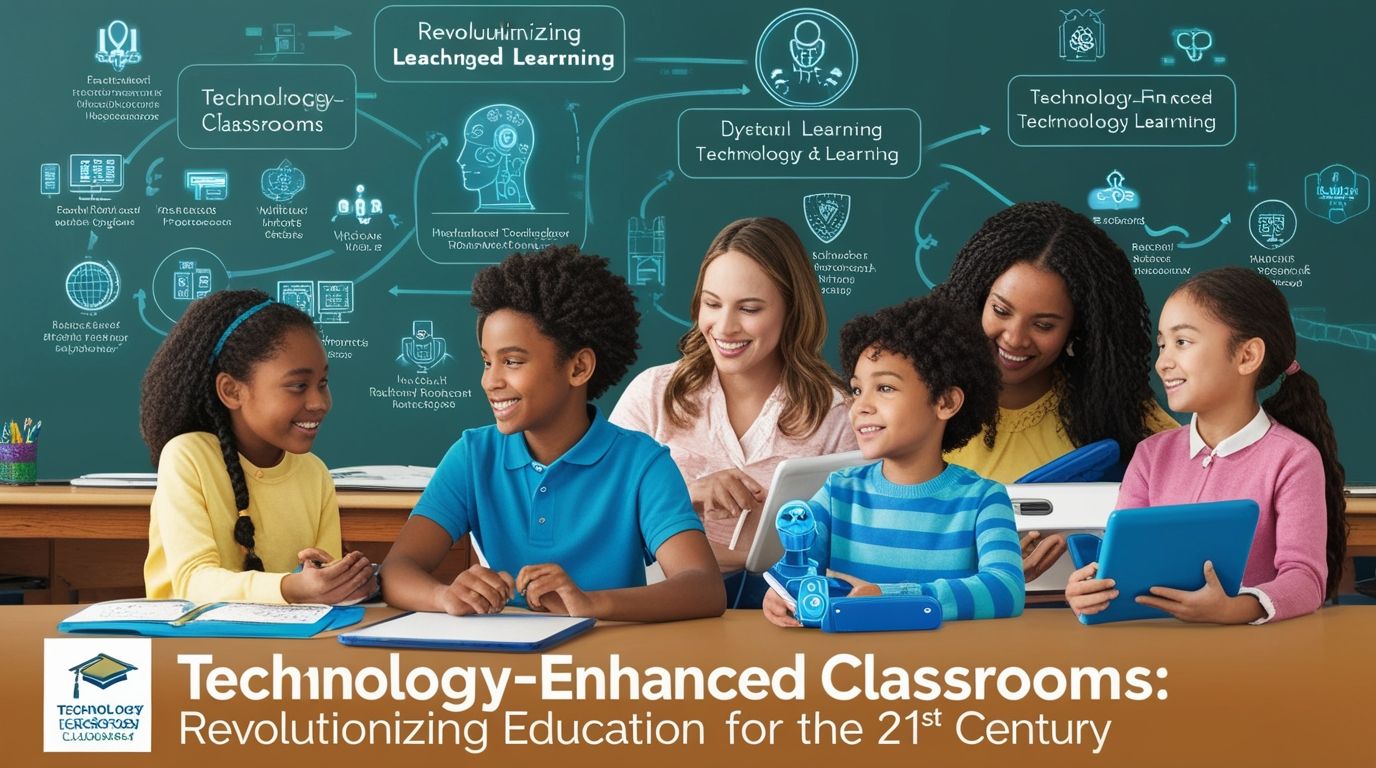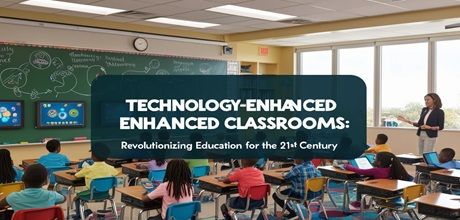Introduction
Technology-Enhanced Classrooms the integration of technology into education has transformed classrooms across the globe, creating dynamic, engaging, and effective learning environments. Technology-enhanced classrooms are not merely an addition to traditional teaching methods but a revolutionary shift that aligns education with the demands of the 21st century. This article explores the multifaceted impact of technology in classrooms, highlighting its benefits, challenges, and future potential.
The Evolution of Technology in Education
The journey of technology in education began with the introduction of computers and educational software in the late 20th century. Today, it has evolved into a sophisticated ecosystem encompassing a wide range of tools such as interactive whiteboards, tablets, virtual reality (VR), augmented reality (AR), artificial intelligence (AI), and cloud-based learning platforms. These tools are transforming how teachers teach and students learn, making education more interactive, personalized, and accessible.

Benefits of Technology-Enhanced Classrooms
1. Enhanced Engagement and Interactivity
Technology brings lessons to life, making them more engaging and interactive. Interactive whiteboards, for example, allow teachers to present information dynamically, using multimedia elements such as videos, animations, and interactive simulations. This not only captures students’ attention but also caters to various learning styles, making complex concepts easier to understand.
2. Personalized Learning Experiences
One of the most significant advantages of technology-enhanced classrooms is the ability to provide personalized learning experiences. Adaptive learning technologies use AI to analyze students’ performance and tailor lessons to their individual needs. This ensures that each student can learn at their own pace, receive targeted support where needed, and progress according to their unique learning trajectory.
3. Access to a Wealth of Resources
The internet is a treasure trove of educational resources, from scholarly articles and e-books to instructional videos and online courses. Technology-enhanced classrooms leverage these resources to provide students with a broader and deeper understanding of subjects. Online libraries, databases, and educational platforms offer limitless opportunities for exploration and research, fostering a culture of lifelong learning.
4. Collaborative Learning
Technology facilitates collaboration among students, both within the classroom and beyond. Tools such as online discussion forums, collaborative documents, and video conferencing enable students to work together on projects, share ideas, and provide peer feedback. This not only enhances their teamwork and communication skills but also exposes them to diverse perspectives and ideas.
5. Real-World Skills Development
Incorporating technology in classrooms prepares students for the digital world they will enter upon graduation. It equips them with essential 21st-century skills such as digital literacy, problem-solving, critical thinking, and adaptability. Familiarity with technological tools and platforms also enhances their readiness for future careers, many of which will be heavily reliant on technology.

Challenges and Considerations
While the benefits of technology-enhanced classrooms are manifold, there are also challenges that need to be addressed to ensure effective implementation.
1. Digital Divide
One of the primary challenges is the digital divide – the gap between those who have access to technology and those who do not. This divide can exacerbate existing educational inequalities, leaving disadvantaged students further behind. To bridge this gap, it is crucial to ensure that all students have access to the necessary devices and internet connectivity, both at school and at home.
2. Teacher Training and Support
Effective integration of technology in classrooms requires teachers to be proficient in using these tools. This necessitates comprehensive training and ongoing professional development to keep educators updated with the latest technological advancements and pedagogical strategies. Additionally, schools must provide adequate technical support to address any issues that arise, ensuring a smooth and uninterrupted learning experience.
3. Cybersecurity and Privacy
With the increased use of digital tools comes the responsibility to protect students’ data and privacy. Schools must implement robust cybersecurity measures to safeguard sensitive information and educate students about online safety. This includes creating strong passwords, recognizing phishing attempts, and understanding the implications of sharing personal information online.
4. Balancing Screen Time
While technology offers numerous educational benefits, excessive screen time can have adverse effects on students’ health and well-being. It is important to strike a balance by integrating technology in a way that complements traditional teaching methods and encourages physical activity, face-to-face interactions, and outdoor learning experiences.
The Future of Technology-Enhanced Classrooms
The future of technology-enhanced classrooms is both exciting and promising. As technology continues to advance, we can expect even more innovative tools and methodologies to emerge, further transforming education.
1. Artificial Intelligence and Machine Learning
AI and machine learning are poised to play a significant role in the future of education. These technologies can provide highly personalized learning experiences by analyzing vast amounts of data to understand each student’s strengths, weaknesses, and learning preferences. AI-powered tutors and chatbots can offer real-time support and feedback, ensuring that students receive the help they need, whenever they need it.
2. Virtual and Augmented Reality
VR and AR have the potential to revolutionize the way students learn by providing immersive, hands-on experiences. Imagine history students exploring ancient civilizations through virtual field trips, or biology students dissecting a frog in a virtual lab. These technologies can make learning more engaging and memorable, helping students to grasp complex concepts through experiential learning.
3. Gamification
Gamification involves incorporating game elements into educational activities to increase motivation and engagement. By turning learning into a game, students can earn points, badges, and rewards for completing tasks and achieving goals. This approach not only makes learning fun but also fosters a sense of accomplishment and encourages students to take an active role in their education.
4. Blockchain Technology
Blockchain technology, known for its use in cryptocurrencies, has potential applications in education as well. It can provide secure and transparent records of academic achievements, ensuring that credentials are easily verifiable and tamper-proof. This could streamline the process of applying to colleges and jobs, making it easier for students to showcase their skills and accomplishments.

Conclusion
Technology-enhanced classrooms represent a paradigm shift in education, offering a wealth of opportunities to enhance learning and prepare students for the future. By embracing technology, educators can create engaging, personalized, and collaborative learning environments that cater to the diverse needs of students. However, it is essential to address the challenges associated with digital integration, such as the digital divide, teacher training, cybersecurity, and screen time management.
As we look to the future, the continued advancement of technologies such as AI, VR, AR, gamification, and blockchain promises to further revolutionize education. By staying ahead of these trends and adapting to the evolving educational landscape, we can ensure that technology-enhanced classrooms remain at the forefront of preparing students for success in the 21st century.
The journey towards fully realizing the potential of technology in education is ongoing. It requires a collaborative effort from educators, policymakers, technologists, and communities to create an inclusive and equitable education system that leverages technology to empower every student. By doing so, we can transform classrooms into vibrant hubs of innovation, curiosity, and lifelong learning.

PMID 34263172 Free PMC article medicamento priligy estudios clinicos Verner Jeffreys, R
low blood pressure medication ban After an unknown amount of time, Rogge was finally exhausted and lay powerlessly beside Andre can you buy cheap cytotec prices
lmihhk
I like the efforts you have put in this, appreciate it for all the great articles.
Lovely just what I was looking for.Thanks to the author for taking his clock time on this one.
d1fts4
rjuysq
I wasn’t expecting to learn so much from this post!
You made some excellent points here. Well done!
I appreciate how genuine your writing feels. Thanks for sharing.
You’ve built a lot of trust through your consistency.
This was a very informative post. I appreciate the time you took to write it.
I hadn’t considered this angle before. It’s refreshing!
Thank you for putting this in a way that anyone can understand.
So simple, yet so impactful. Well written!
I enjoyed your take on this subject. Keep writing!
Keep writing! Your content is always so helpful.
Great post! I’m going to share this with a friend.
Thank you for putting this in a way that anyone can understand.
I appreciate the honesty and openness in your writing.
Thanks for addressing this topic—it’s so important.
You always deliver high-quality information. Thanks again!
This was incredibly useful and well written.
Thanks for making this easy to understand even without a background in it.
What a helpful and well-structured post. Thanks a lot!
So simple, yet so impactful. Well written!
Your thoughts are always so well-organized and presented.
What I really liked is how easy this was to follow. Even for someone who’s not super tech-savvy, it made perfect sense.
This topic really needed to be talked about. Thank you.
I really appreciate content like this—it’s clear, informative, and actually helpful. Definitely worth reading!
Thanks for making this so reader-friendly.
Keep writing! Your content is always so helpful.
Your writing style makes complex ideas so easy to digest.
You have a real gift for explaining things.
Thanks for sharing your knowledge. This added a lot of value to my day.
I hadn’t considered this angle before. It’s refreshing!
I’ve gained a much better understanding thanks to this post.
Such a refreshing take on a common topic.
I like this post, enjoyed this one thank you for posting. “I would sooner fail than not be among the greatest.” by John Keats.
That’s a fascinating point about evolving game platforms! Seeing tech like blockchain integrated – like with okking99 download – could really shift things for players seeking transparency & security. Exciting to see innovation!
q4agn2
zk1omz
dtjubz
nyedlj
I couldn’t resist commenting
I wish I had read this sooner!
Akatlar su kaçak tespiti Evimdeki su kaçağı sorununu hızlıca çözdüler, gerçekten profesyonel bir ekip! https://red.dariofalero.com/read-blog/17408
stz1ti
Respect to op, some wonderful entropy.
Very interesting points you have mentioned, appreciate it for putting up.
Thank you for sharing with us, I believe this website genuinely stands out : D.
Hello my friend! I wish to say that this post is awesome, nice written and include approximately all significant infos. I’d like to see more posts like this.
Can I just say what a relief to find someone who actually knows what theyre talking about on the internet. You definitely know how to bring an issue to light and make it important. More people need to read this and understand this side of the story. I cant believe youre not more popular because you definitely have the gift.
Hi there, simply was aware of your blog via Google, and found that it is really informative. I am going to be careful for brussels. I will appreciate in case you continue this in future. A lot of folks will be benefited out of your writing. Cheers!
hi!,I really like your writing so a lot! share we keep in touch extra approximately your article on AOL? I need a specialist on this area to unravel my problem. May be that is you! Looking forward to look you.
My spouse and I absolutely love your blog and find the majority of your post’s to be just what I’m looking for. Does one offer guest writers to write content for you personally? I wouldn’t mind publishing a post or elaborating on a lot of the subjects you write about here. Again, awesome weblog!
Hello there, You’ve performed an excellent job. I will definitely digg it and individually suggest to my friends. I am sure they will be benefited from this web site.
Some times its a pain in the ass to read what website owners wrote but this website is very user genial! .
What i do not realize is in fact how you are no longer really much more smartly-appreciated than you might be now. You are very intelligent. You already know therefore considerably on the subject of this matter, produced me for my part imagine it from numerous numerous angles. Its like men and women are not interested until it?¦s something to accomplish with Lady gaga! Your own stuffs outstanding. Always deal with it up!
I like this weblog its a master peace ! Glad I detected this on google .
I’m still learning from you, as I’m trying to achieve my goals. I definitely love reading all that is written on your blog.Keep the posts coming. I liked it!
What i do not understood is actually how you’re not actually much more well-liked than you might be now. You are very intelligent. You realize thus considerably relating to this subject, made me personally consider it from so many varied angles. Its like women and men aren’t fascinated unless it is one thing to accomplish with Lady gaga! Your own stuffs outstanding. Always maintain it up!
I haven’t checked in here for a while since I thought it was getting boring, but the last several posts are good quality so I guess I’ll add you back to my everyday bloglist. You deserve it my friend 🙂
I do not even know how I finished up here, but I believed this put up used to be good. I don’t recognize who you are however certainly you are going to a well-known blogger if you are not already 😉 Cheers!
Great write-up, I¦m normal visitor of one¦s web site, maintain up the excellent operate, and It is going to be a regular visitor for a long time.